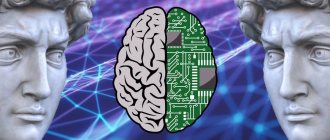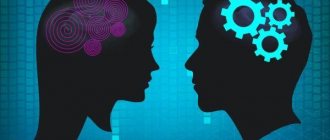In this article, medical doctors will help you understand the symptoms of stroke and micro-stroke and tell you what to do if a person has an attack.
A stroke is a cerebrovascular accident that causes a blood vessel to become blocked or ruptured when a blood clot disrupts the flow of blood to the brain. Brain cells die from lack of nutrition and oxygen, which leads to impaired speech, cognitive and motor functions. If a person does not receive timely assistance, death occurs within 2–3 hours.
About microstroke
“Micro-stroke, symptoms, first signs in women” is the topic of our article today.
Minor stroke, transient ischemic attack (TIA) , transient cerebrovascular accident - different names for the same vascular process - micro-stroke.
A microstroke is a local lesion of the blood vessels of the brain , has a number of similar symptoms to a large stroke, but its manifestations are not so pronounced, and the attack is characterized by “transience”, lasting from several minutes to a day.
Men and women can be equally exposed to transient ischemic attack , but due to the natural differences between male and female bodies, the course of the process will differ in the clinic.
Differences between a microstroke and a stroke
A microstroke is a transient circulatory disorder in the cerebral vessels . It occurs against the background of constantly elevated blood pressure, its sharp rise, or atherosclerosis, when cholesterol plaques are deposited on the inner walls of blood vessels.
Important! Regularly measure your blood pressure with a tonometer, if you don’t have a tonometer, be sure to buy one, it’s not expensive, but every family should have it, here (on Aliexpress) you can always choose an inexpensive option.
The mechanisms of development of TIA and stroke are the same, they are similar in manifestations and symptoms:
- Bursting pain appears in the back of the head.
- You can clearly feel the blood pulsating in your temples.
- The sense of orientation disappears even in a familiar, familiar space.
- Limbs become numb and swollen. Swelling begins in the toes and feet, then swells in the fingers and forearms.
- Hyperhidrosis begins - increased sweat production throughout the body.
- The heart rhythm is lost.
- Both with a micro-stroke and with a large stroke, dizziness, fainting, and loss of consciousness are noted.
- In both the first and second cases, a change in vision is noted: “spots” or colored spots or circles appear before the eyes. At the very beginning of attacks, objects may look unnatural
- bright and clear, after a few minutes the colors fade, the surroundings are seen as if through a veil or fog.
- Loud sounds and bright colors begin to irritate.
- Paresis develops.
- Dysphagia develops - a violation of the swallowing reflex.
- Facial facial muscles are affected. And as a result, facial distortion occurs. A crooked, lopsided smile appears on the face, and the corners of the mouth droop.
Both during a stroke and during a transient ischemic attack, the whites of the eyes may turn red. In both cases, confusion and speech disturbances may occur, when it becomes slurred and difficult to understand.
Mucofalk or Fitomucil, which is better, reviews from doctors
With all this, the processes differ in clinical picture:
- The symptoms of a microstroke are less pronounced.
- All manifestations of TIA disappear in a short period of time, the maximum duration of an attack is 24 hours, but usually it lasts no more than a few minutes.
- With a microstroke, a rapid heartbeat is observed, the skin of the face turns red; With a major stroke, the heart rate slows and the face turns pale. Facial pallor during a stroke is an alarming sign indicating a serious condition of the patient.
- With a microstroke, paresis develops - partial loss of motor activity; with a stroke, complete paralysis of the upper or lower extremities is possible.
- With a major stroke, large vessels supplying a given area of the brain are blocked or ruptured and, as a result, necrosis of the affected area and death of its nerve cells occurs. With a microstroke, small vessels are affected - capillaries and arterioles, the recovery of which occurs faster.
- In case of a microstroke, examination for the Babinski reflex will always give a negative result.
- With TIA, there is no enuresis; with a stroke, urinary incontinence is one of the constant symptoms.
- With a microstroke, gaze paresis does not develop, when friendly eye movement becomes impossible.
- With a microstroke, the pupils are the same size. With a stroke, anisocoria develops when one pupil is enlarged and the second is reduced in size.
This is the danger of a micro-stroke - in most cases it is endured “on your feet” , once, twice, three times, until an acute vascular catastrophe occurs, a major stroke. In case of a stroke, doctors have negligible time left to save the patient - only four and a half hours.
What are the causes, symptoms, consequences of this phenomenon?
The causes of TIA are atherosclerotic damage to the arteries, arterial hypertension, heart disease, diabetes mellitus, etc. The above reasons account for approximately 95% of TIAs and are dominant in elderly and senile people. In approximately 5% of cases, more often in young people.
TIAs are caused by other reasons:
- arterial dissection;
- vasculitis, congenital anomalies of the arteries;
- migraine;
- hematological disorders;
- infections;
- malignant neoplasms;
- oral contraceptives;
- pregnancy and postpartum period;
- pathological tortuosity of blood vessels;
- extravasal compression of the vertebral arteries by pathologically altered cervical vertebrae.
It should be noted that TIA is characterized by a sudden onset and rapid regression of symptoms, most often within 1 hour.
You need to pay attention to the following symptoms:
- Weakness in one upper and/or lower limb. Facial paralysis may occur.
- Numbness of half the face and/or limbs.
- Transient visual impairment in one eye.
- Speech disorders: difficulties in remembering words, pronouncing or perceiving words.
- Coordination problems: Loss of balance when moving your arms, legs, or body. The patient may stagger or fall when walking or standing.
- Diplopia: double or blurred image.
- Dizziness: The patient describes it not as a strange sensation in the head, but as if he himself is dizzy.
- Difficulty swallowing.
- Behavioral disturbances: the patient does not perceive what is said or makes uncoordinated movements. Possibly excessive sleep cravings. Possible agitation or psychosis.
TIA can be a precursor to all types of stroke, but most often precedes the development of atherothrombotic stroke. Against the background of TIA, 25-50% of atherothrombotic strokes, 11-30% of cardioembolic, 11-14% of lacunar and 9-11% of hemorrhagic strokes develop.
Distinctive features of female and male microstroke
Despite the similarity of symptoms and clinical picture, there are a number of specific differences between a “female” microstroke and a “male” one :
| Microstroke in women | Microstroke in men |
| The changes affect the vessels located in the occipital part of the head. This disrupts blood flow to the occipital and temporal lobes, cerebellum, and brain stem. | The vessels located in the front of the head are affected |
| Emotions are not controlled; the transition from tears to aggression can take several minutes. Mental disorders are one of the signs of a “female” microstroke | Changes in mental state occur rarely; a man is able to control his psycho-emotional state. |
| The risk of developing cerebrovascular accident is higher if a woman: · had an abortion or miscarriage; · had complications during pregnancy | The risk of developing TIA in men has nothing to do with reproductive function |
| The recovery period takes longer, there is a high risk of relapse with more severe symptoms | Recovery is faster, consequences are less obvious |
What causes a mini stroke?
There are many negative factors that significantly increase the risk of developing the disease in question. Here are the main ones:
- Too hard physical labor and working with weights that place an undue burden on the body;
- Dependence on harmful substances: nicotine, drugs or alcohol;
- Excessive excess body weight;
- Constant lack of sleep, the influence of stress, depression, constant worries and worries;
- Eating junk food, violating the basics of proper nutrition;
- Working in hazardous conditions;
- Poisoning of the body with substances that can provoke vascular spasms.
Also, the likelihood of a mini-stroke increases significantly with diseases such as:
- Increased level of blood viscosity;
- Problems with blood vessels: their inflammation, any congenital anomalies;
- Heart diseases;
- Thrombosis
- Diabetes.
The factor of heredity may play an important role. Even in the absence of the diseases mentioned, the risk of experiencing a mini-stroke increases significantly for every man aged 45 years or older.
Early subtle signs of microstroke in women
Early neurological symptoms depend on which part of the brain is affected by the ischemic attack.
Eye drops for lacrimation for the elderly [Top 23 drugs]
So, if the blood vessels of the parietal lobe are affected, there is a decrease or complete loss of tactile sensitivity . It is impossible to determine the characteristics of an object with closed eyes, it is impossible to determine whether it is cold or warm, what kind of surface it has, smooth or rough; What shape is it - square, round, triangular.
When the occipital lobe is damaged, ophthalmological problems : vision decreases, it is impossible to visually identify even well-known objects.
The manifestations of a microstroke are surprising when the temporal lobe is affected. There are lapses in memory and a feeling of “déjà vu” - “recognition of the past,” a mental state when a person “remembers” a place, situation or event.
The following are considered as common and earliest manifestations of microstroke in women:
- Semi-fainting conditions, accompanied by constant dizziness and severe headaches.
- Nausea, retching, or vomiting directly.
- Redness of the face and whites of the eyes.
- Characteristic tingling in the limbs.
Types of microstrokes
Microstrokes are divided into two types, based on the cause of their occurrence:
- Ischemic occurs when the blood supply to certain parts of the brain is stopped due to obstruction of blood vessels or arteries. It does not matter what blocked the blood flow - a blood clot, a blood clot or an overgrown atherosclerotic plaque.
- A hemorrhagic stroke is a microstroke that occurs as a result of a hemorrhage that occurs when a small vessel ruptures. In addition, thinning of the vascular wall is also a risk of intracerebral hemorrhage.
Both conditions are dangerous and require the help of qualified professionals.
Noticeable signs of the disease
As the process develops, the symptoms and first signs of a microstroke in women become brighter. This is exactly the moment when a microstroke can be differentiated from other diseases:
- Facial expressions are disrupted. When trying to smile, one corner of the mouth remains motionless, the smile turns out to be “crooked.”
- The sense of orientation in space disappears.
- Memory lapses begin.
- Numbness in fingers or toes.
- Vision is partially lost. An object or image is not completely visually perceived; only its right or left side is visible. With a microstroke, one of the symptoms is photopsia. a phenomenon where “floaters”, colored spots, zigzags or circles appear before the eyes.
- Muscle tone sharply decreases, the body is subjected to a drop attack, when a person suddenly loses consciousness for no apparent reason.
- In some cases, Wallenberg-Zakharchenko syndrome is observed - loss of coordination on one side of the body, unsteadiness of gait, dragging of the legs, inability to maintain balance.
Symptoms of a microstroke
Due to the fact that the symptoms of a microstroke are short-term, sometimes it is not possible to accurately determine the cause of the ailment. The main signs of a microstroke are:
- increasing and persistent headache;
- sudden deterioration in condition without obvious reasons;
- dizziness, loss of coordination;
- numbness of the tips of the fingers and toes, especially predominantly on one side of the body;
- decreased visual acuity - cloudy picture, blurry shapes;
- goosebumps without obvious provoking factors;
- heavy sweating;
- manifestation of facial asymmetry.
If the patient himself can feel a headache and numbness of the limbs, then the asymmetry of facial expressions becomes noticeable at first only to the person next to him. It is this sign that should be considered indicative in the matter of making a diagnosis. At the first manifestations of asymmetry, you should immediately call an ambulance.
Most often, strokes and micro-strokes occur when changing body position. For example, after a person gets up from a sitting or lying position and walks. The position has changed, the blood flow has accelerated, the pressure has increased for a short time - these are provoking factors that can contribute to the removal of a fragment of a blood clot from the vessel wall and blockage of small capillaries or arteries.
Symptoms and warning signs that should prompt you to see a doctor
Symptoms of microstroke in women quickly disappear; often the disease can be diagnosed only in a medical institution.
There are several “ifs”, the combination of which makes it necessary to see a doctor:
- If severe and persistent headaches begin.
- If you see black or colored circles, spots, lightning before your eyes.
- If your heart rate and pulse rate are abnormal.
- If the limbs lose sensation.
- If control over facial expressions is lost.
- If one eye is in normal condition, and the other is half-closed.
- If speech is impaired and it is impossible to pronounce a logically completed phrase.
- If coordination is impaired and movements become uncoordinated.
What happens if you ignore a microstroke?
Statistics say that in ten out of a thousand people, TIA leads to the development of a stroke within the next three months.
Five out of a thousand people are admitted to hospital during the course of a year with a diagnosed ischemic stroke.
What is better, Nitroxoline or Furadonin for cystitis?
Ten to twelve people out of a thousand will be struck within five years after the first micro-stroke.
Providing first aid for a microstroke
If it is impossible to quickly call a doctor, follow this algorithm:
- The patient is placed in bed, providing unhindered access to fresh air.
- They give you a tablet of Aspirin, Agrenox or, if they are intolerant, Clopidogrel.
- To improve blood flow and protect brain neurons, give Piracetam or Vinpocetine.
- Blood pressure is measured, and if its first number exceeds 200, it is slowly lowered. Furosemide or Captopril are used.
- In diabetes mellitus, glucose levels are reduced.
For micro-strokes, do not take popular painkillers containing caffeine (Citramon), as they increase blood pressure even more.
Check out the list of the best blood pressure pills.
Causes of microstroke
The causes of a microstroke can be various pathologies associated with the condition of the heart and blood vessels, diet, lifestyle and arterial hypertension. At risk are young people over 35 years of age who are overweight and suffer from nicotine addiction. Smoking is a habit due to which a person himself spoils the condition of his blood vessels, reducing their elasticity, narrowing the lumen and increasing pressure.
The main causes of microstroke identified by doctors:
- tendency to thrombosis;
- atherosclerosis;
- tachycardia;
- hypertension;
- arrhythmia;
- weather dependence;
- diabetes;
- hormonal imbalance;
- osteochondrosis of the cervical spine.
The lifestyle of a modern person often provokes the formation of factors that contribute to the occurrence of a micro-stroke. Nutrition has a great influence on health. Love for sausage products is a big step towards a micro-stroke. Also, dangerous foods include:
- frequent consumption of fried pies, pasties, sausages in dough;
- starting each day with fried eggs;
- abuse of chips, hamburgers, snacks;
- a large amount of vegetable oil used for preparing fried foods.
A sedentary lifestyle helps cholesterol from harmful foods to be released and deposited on the walls of blood vessels, reducing their permeability. When the morning does not start with exercise, and the evening ends on the couch instead of walking in the fresh air, adipose tissue builds up, increasing the load on the heart, resulting in an increase in blood pressure and heart rate.
Treatment (therapy) of microstroke
When treating a microstroke, the following is prescribed:
- Thrombolytics : drugs that kill blood clots, restore blood flow, dissolve blood clots. Indicated for micro-strokes and ischemic strokes. But their use in hemorrhagic stroke leads to the death of the patient.
- Anticoagulants : reduce blood clotting and prevent blood clots.
- Disaggregants : prevent blood cells from joining into a single clot.
- Diuretics : relieve swelling in brain tissue.
- Neuroprotectors : restorative therapy drugs that support brain cells and reduce the risk of relapse.
Treatment includes physical therapy classes, water treatments, massages, breathing exercises, and diet. An important factor in eliminating relapses and maintaining vascular activity is giving up alcohol and smoking and controlling weight.
Competent treatment
In case of a mini-stroke, it is important to provide timely assistance to the person and prescribe effective treatment. To restore blood flow in the damaged area of the brain, doctors prescribe the use of metabolic and vasodilating drugs, antiplatelet agents, nootropics, angioprotectors, etc.
The consequences of a mini-stroke can be very different: memory impairment, absent-mindedness, depression, aggressiveness. In some cases, the patient experiences an ischemic or hemorrhagic stroke within a few days.
Consequences of a mini-stroke
TIA does not go away without a trace. The symptoms will disappear, but the attack will happen again and again. In 300 people out of a thousand, TIA will lead to the development of a stroke - its most severe and most dangerous consequence.
There are two types of stroke development:
- Ischemic (the most common consequence of a microstroke), when blood flow to a certain area of the brain stops. It is the result of either a blood clot that has closed the vessel or prolonged vascular spasm.
- Hemorrhagic (rarely develops after TIA, considered only as a special case) - a severe brain catastrophe, the result of a breakthrough of large vessels and hemorrhage in the brain.
During a stroke, cells in large areas of the brain die, the patient develops paresis and plegia with complete or partial loss of sensitivity, the person ceases to adequately assess the situation, memory loss occurs, and in some cases, swallowing dysfunction occurs.
In addition to the risk of stroke, recurrent TIAs threaten:
- decline in intelligence;
- memory impairment;
- changes in mental state, lack of control over emotions and their frequent changes, when from tears to aggression, from irritability to apathy and depression - one step.
Today TIA is “getting younger.” Micro-strokes are diagnosed in women who have barely crossed the 30-year mark. Neither self-medication nor letting the disease “go on its own” is permissible, because the consequences can lead to irreversible changes.
Consequences
If you pay attention to alarming symptoms in time, then timely and high-quality treatment will allow you to avoid noticeable consequences, even if the woman suffered the disease on her legs.
If a full examination is not completed, there is a risk of deterioration in cognitive function and general psychological well-being. People who did not receive help in time experience deterioration in their memory and ability to concentrate. In addition, patients experience mood problems. Often, even calm and balanced women face outbreaks of causeless sadness, aggression or even depression.
One of the most dangerous consequences is a recurrence or development of a full-fledged stroke, which can seriously impair the quality of life.








